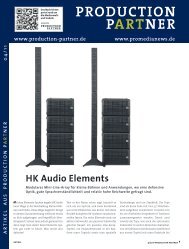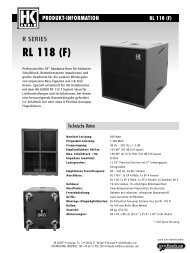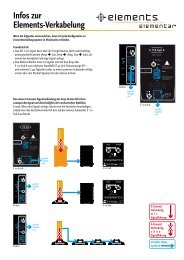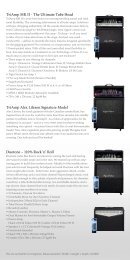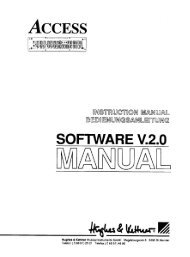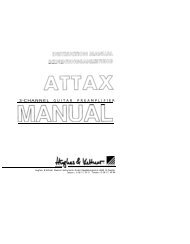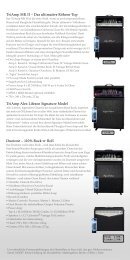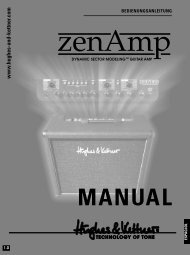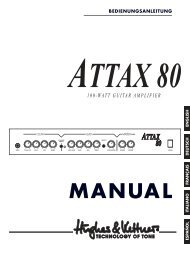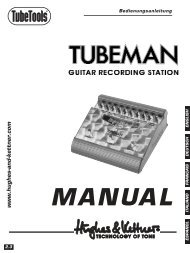Create successful ePaper yourself
Turn your PDF publications into a flip-book with our unique Google optimized e-Paper software.
IMPORTANT ADVICE ON SAFETY!<br />
PLEASE READ BEFORE USE AND KEEP FOR LATER USE!<br />
• The unit has been built by Hughes & Kettner in accordance with IEC 60065 and left the<br />
factory in safe working order. To maintain this condition and ensure non-risk operation,<br />
the user must follow the advice and warning comments found in the operating<br />
instructions. The unit conforms to Protection Class 1 (protectively earthed).<br />
• HUGHES & KETTNER ONLY GUARANTEE THE SAFETY, RELIABILITY AND EFFICIENCY OF THE<br />
UNIT IF:<br />
• Assembly, extension, re-adjustment, modifications or repairs are carried out by<br />
Hughes & Kettner or by persons authorized to do so.<br />
• The electrical installation of the relevant area complies with the requirements of<br />
IEC (ANSI) specifications.<br />
•The unit is used in accordance with the operating instructions.<br />
• The unit is regularly checked and tested for electrical safety by a competent technician.<br />
WARNING:<br />
• If covers are opened or sections of casing are removed, except where this can be<br />
done manually, live parts can become exposed.<br />
• If it is necessary to open the unit this must be isolated from all power sources. Please<br />
take this into account before carrying out adjustments, maintenance, repairs and<br />
before replacing parts.<br />
• Adjustment, maintenance and repairs carried out when the unit has been opened<br />
and is still live may only be performed by specialist personnel who are authorized by<br />
the manufacturer (in accordance with VBG 4) and who are aware of the associated<br />
hazards.<br />
• Loudspeaker outputs which have the IEC 417/5036 symbol (Diagram 1, below) can<br />
carry voltages which are hazardous if they are made contact with. Before the unit is<br />
switched on, the loudspeaker should therefore only be connected using the lead<br />
recommended by the manufacturer.<br />
• Where possible, all plugs on connection cables must be screwed or locked onto the<br />
casing.<br />
• Replace fuses using only those of the specified type and current rating.<br />
• It is not permitted to use repaired fuses or to short-circuit the fuse holder.<br />
• Never interrupt the protective conductor connection.<br />
• Surfaces which are equipped with the „HOT“ mark (Diagram 2, below), rear panels or<br />
covers with cooling slits, cooling bodies and their covers, as well as tubes and their<br />
covers are purposely designed to dissipate high temperatures and should therefore<br />
not be touched.<br />
• High loudspeaker levels can cause permanent hearing damage. You should therefore<br />
avoid the direct vicinity of loudspeakers operating at high levels. Wear hearing protection<br />
if continuously exposed to high levels.<br />
MAINS CONNECTION:<br />
• The unit is designed for continuous operation.<br />
• The set operating voltage must match the local mains supply voltage.<br />
• Caution: The unit mains switch must be in position OFF before the mains cable is<br />
connected.<br />
• The unit is connected to the mains via the supplied power unit or power cable.<br />
• Power unit: Never use a damaged connection lead. Any damage must be rectified<br />
by a competent technician.<br />
• Avoid connection to the mains supply in distributor boxes together with several other<br />
power consumers.<br />
• The plug socket for the power supply must be positioned near the unit and must be<br />
easily accessible.<br />
PLACE OF INSTALLATION:<br />
• The unit should stand only on a clean, horizontal working surface.<br />
• The unit must not be exposed to vibrations during operation.<br />
• Keep away from moisture and dust where possible.<br />
• Do not place the unit near water, baths, wash basins, kitchen sinks, wet areas, swimming<br />
pools or damp rooms. Do not place objects containing liquid on the unit - vases,<br />
glasses, bottles etc.<br />
• Ensure that the unit is well ventilated.<br />
• Any ventilation openings must never be blocked or covered. The unit must be positioned<br />
at least 20 cm away from walls. The unit may only be fitted in a rack if adequate<br />
ventilation is ensured and if the manufacturer’s installation instructions are followed.<br />
• Keep away from direct sunlight and the immediate vicinity of heating elements and<br />
radiant heaters or similar devices.<br />
• If the unit is suddenly moved from a cold to a warm location, condensation can form<br />
inside it. This must be taken into account particularly in the case of tube units. Before<br />
switching on, wait until the unit has reached room temperature.<br />
• Accessories: Do not place the unit on an unsteady trolley, stand, tripod, base or table.<br />
If the unit falls down, it can cause personal injury and itself become damaged. Use<br />
the unit only with the trolley, rack stand, tripod or base recommended by the manufacturer<br />
or purchased together with the unit. When setting the unit up, all the manufacturer’s<br />
instructions must be followed and the setup accessories recommended by<br />
the manufacturer must be used. Any combination of unit and stand must be moved<br />
carefully. A sudden stop, excessive use of force and uneven floors can cause the<br />
combination of unit and stand to tip over.<br />
• Additional equipment: Never use additional equipment which has not been recommended<br />
by the manufacturer as this can cause accidents.<br />
• To protect the unit during bad weather or when left unattended for prolonged periods,<br />
the mains plug should be disconnected. This prevents the unit being damaged<br />
by lightning and power surges in the AC mains supply.<br />
Diagram 1 Diagram 2<br />
CONSEILS DE SECURITE IMPORTANTS!<br />
PRIERE DE LIRE AVANT L’EMPLOI ET A CONSERVER POUR UTILISATION ULTERIEURE!<br />
•L’appareil a été conçu par Hughes & Kettner selon la norme IEC 60065 et a<br />
quitté l’entreprise dans un état irréprochable. Afin de conserver cet état et<br />
d’assurer un fonctionnement sans danger de l’appareil nous conseillons à l’utilisateur<br />
la lecture des indications de sécurité contenues dans le mode d’emploi.<br />
L’appareil est conforme à la classification I (mise à terre de protection).<br />
•SURETE, FIABILITE ET EFFICACITE DE L’APPAREIL NE SONT GARANTIS PAR<br />
HUGHES & KETTNER QUE SI:<br />
• Montage, extension, nouveau réglage, modification ou réparation sont<br />
effectués par Hughes & Kettner ou par toute personne autorisée par<br />
Hughes & Kettner.<br />
• L’installation électrique de la pièce concernée correspond aux normes IEC (ANSI).<br />
• L’utilisation de l’appareil suit le mode d’emploi.<br />
AVERTISSEMENT:<br />
•A moins que cela ne soit manuellement possible, tout enlèvement ou ouverture<br />
du boîtier peut entrainer la mise au jour de pieces sous tension.<br />
• Si l’ouverture de l’appareil est nécessaire, celui-ci doit être coupé de chaque<br />
source de courant. Ceci est à prendre en considération avant tout ajustement,<br />
entretien, réparation ou changement de pieces.<br />
•Ajustement, entretien ou réparation sur l’appareil ouvert et sous tension ne<br />
peuvent être éffectués que par un spécialiste autorisé par le fabricant (selon<br />
VBG4). Le spécialiste étant conscient des dangers liés à ce genre de<br />
réparation.<br />
• Les sorties de baffles qui portent le signe IEC 417/5036 (fig. 1, voir en bas)<br />
peuvent être sous tension dangereuse. Avant de brancher l’appareil utiliser<br />
uniquement le câble de raccordement conseillé par le fabricant pour<br />
raccorder les baffles.<br />
•Toutes les prises des câbles de raccordement doivent être, si possible, vissées<br />
ou verrouillées sur le boîtier.<br />
• Utilisez subsidiairement uniquement des fusibles de type et de puissance de<br />
courant nominale donnés.<br />
• L’utilisation de fusibles rafistolés ou court-circuites est inadmissible.<br />
•Ne jamais interrompre la connexion du circuit protecteur.<br />
• Il est conseillé de ne pas toucher aux surfaces pourvues du signe „HOT“ (fig. 2,<br />
voir en bas), aux parois arrières ou caches munis de fentes d’aération,<br />
éléments d’aération et leurs caches ansi qu’aux tubes et leurs caches. Ces<br />
éléments pouvant atteindre des températures élévées pendant l’utilisation de<br />
l’appareil.<br />
• Les Niveaux de puissance élévés peuvent entrainer des lésions auditives<br />
durables. Evitez donc la proximité de haut-parleurs utilisés à haute puissance.<br />
Lors de haute puissance continue utilisez une protection auditive.<br />
BRANCHEMENT SUR LE SECTEUR:<br />
•L’appareil est conçu pour une utilisation continue.<br />
• La tension de fonctionnement doit concorder avec la tension secteur locale.<br />
• Attention: L’interrupteur de secteur de l’appareil doit être sur la position OFF,<br />
lorsque le câble de réseau est raccordé.<br />
• Le raccordement au réseau éléctrique s’effectue avec l’adaptateur ou le<br />
cordon d´alimentation livré avec l’appareil.<br />
• Adaptateur: Un câble de raccordement abimé ne peut être remplacé.<br />
L’adaptateur est inutilisable.<br />
• Evitez un raccordement au réseau par des boîtes de distribution surchargées.<br />
• La prise de courant doit être placée à proximité de l’appareil et facile à<br />
atteindre.<br />
LIEU D’INSTALLATION:<br />
•L’appareil doit être placé sur une surface de travail propre et horizontale.<br />
•L’appareil en marche ne doit en aucun cas subir des vibrations.<br />
• Evitez dans la mesure du possible poussière et humidité.<br />
•L’appareil ne doit pas être placé à proximité d’eau, de baignoire, lavabo,<br />
évier, pièce d’eau, piscine ou dans une pièce humide. Ne placez aucun vase,<br />
verre, bouteille ou tout objet rempli de liquide sur l’appareil.<br />
•L’appareil doit être suffisamment aéré.<br />
• Ne jamais recouvrir les ouvertures d’aération. L’appareil doit être placé à 20 cm<br />
du mur au minimum. L’appareil peut être monté dans un Rack si une<br />
ventilation suffisante est possible et si les conseils de montage du fabricant<br />
sont suivis.<br />
• Evitez les rayons de soleil et la proximité de radiateurs, chauffages etc.<br />
• Une condensation d’eau peut se former dans l’appareil si celui-ci est transporté<br />
brusquement d’un endroit froid à un endroit chaud. Ceci est particulièrement<br />
important pour des appareils à tubes. Avant de brancher l’appareil attendre<br />
qu’il ait la température ambiante.<br />
• Accessoires: L’appareil ne doit être placé sur un chariot, support, trépied, bâti<br />
ou table instable. Une chute de l’appareil peut entrainer aussi bien des<br />
dommages corporels que techniques. Utilisez l’appareil uniquement avec un<br />
chariot, Rack, support, trépied ou bâti conseillé par le fabricant ou vendu en<br />
combinaison avec l’appareil. Les indications du fabricant pour l’installation de<br />
l’appareil sont à suivre, et les accessoires d’installation conseillés par le<br />
fabricant sont à utiliser. Un ensemble support et appareil doit être déplacé<br />
avec précaution. Des mouvements brusques et des revêtements de sol<br />
irreguliers peuvent entrainer la chute de l´ensemble.<br />
• Equipements supplémentaires: Ne jamais utiliser un équipement supplémentaire<br />
n’ayant pas été conseillé par le fabricant, ceci pouvant entrainer des<br />
accidents.<br />
• Afin de protéger l’appareil pendant un orage ou s’il ne doit pas être utilisé<br />
pendant un certain temps, il est conseillé d’enlever la prise au secteur. Ceci<br />
évite des dommages dûs à la foudre ou à des coups de tension dans le réseau<br />
à courant alternatif.<br />
Fig. 1 Fig. 2<br />
65



